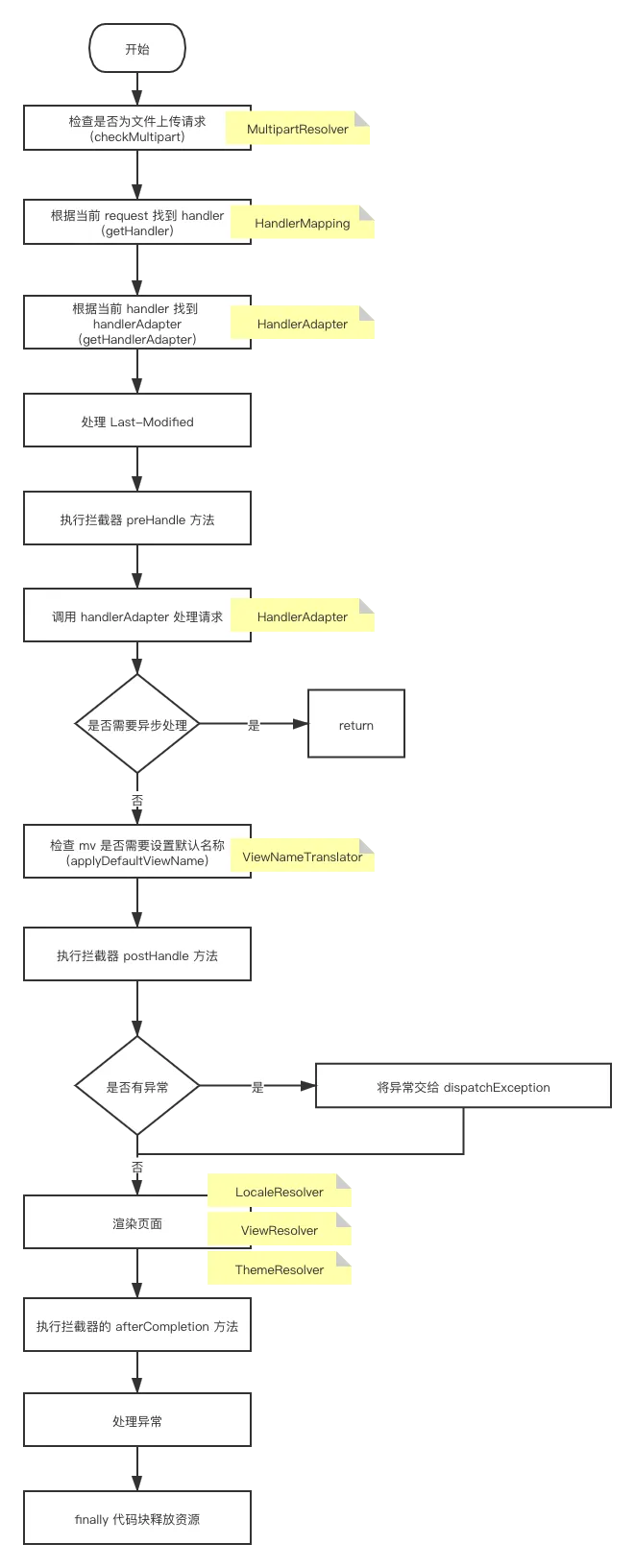SpringMVC 源码分析之 DispatcherServlet
前面松哥和大家聊了 DispatcherServlet 的父类 FrameworkServlet,大家从中了解到在 DispatcherServlet 中,方法执行的入口应该是 doService。如果小伙伴们还没看前面的分析,可以先看下,这有助于理解本文,传送门SpringMVC 源码分析之 FrameworkServlet。
即使你没看过 DispatcherServlet 的源码,估计也听说过:DispatcherServlet 是 SpringMVC 的大脑,它负责整个 SpringMVC 的调度工作,是 SpringMVC 中最最核心的类,SpringMVC 整个顶层架构设计都体现在这里,所以搞明白 DispatcherServlet 的源码,基本上 SpringMVC 的工作原理也就了然于胸了。
经过上篇文章的分析,大家已经知道 DispatcherServlet 的入口方法是 doService,所以今天我们就从 doService 方法开始看起,松哥将带领大家,一步一步揭开 DispatcherServlet 的面纱。
doService
先来看 doService,把源码先贴上来,然后我们逐步分析:
protected void doService(HttpServletRequest request, HttpServletResponse response) throws Exception {
logRequest(request);
// Keep a snapshot of the request attributes in case of an include,
// to be able to restore the original attributes after the include.
Map<String, Object> attributesSnapshot = null;
if (WebUtils.isIncludeRequest(request)) {
attributesSnapshot = new HashMap<>();
Enumeration<?> attrNames = request.getAttributeNames();
while (attrNames.hasMoreElements()) {
String attrName = (String) attrNames.nextElement();
if (this.cleanupAfterInclude || attrName.startsWith(DEFAULT_STRATEGIES_PREFIX)) {
attributesSnapshot.put(attrName, request.getAttribute(attrName));
}
}
}
// Make framework objects available to handlers and view objects.
request.setAttribute(WEB_APPLICATION_CONTEXT_ATTRIBUTE, getWebApplicationContext());
request.setAttribute(LOCALE_RESOLVER_ATTRIBUTE, this.localeResolver);
request.setAttribute(THEME_RESOLVER_ATTRIBUTE, this.themeResolver);
request.setAttribute(THEME_SOURCE_ATTRIBUTE, getThemeSource());
if (this.flashMapManager != null) {
FlashMap inputFlashMap = this.flashMapManager.retrieveAndUpdate(request, response);
if (inputFlashMap != null) {
request.setAttribute(INPUT_FLASH_MAP_ATTRIBUTE, Collections.unmodifiableMap(inputFlashMap));
}
request.setAttribute(OUTPUT_FLASH_MAP_ATTRIBUTE, new FlashMap());
request.setAttribute(FLASH_MAP_MANAGER_ATTRIBUTE, this.flashMapManager);
}
RequestPath previousRequestPath = null;
if (this.parseRequestPath) {
previousRequestPath = (RequestPath) request.getAttribute(ServletRequestPathUtils.PATH_ATTRIBUTE);
ServletRequestPathUtils.parseAndCache(request);
}
try {
doDispatch(request, response);
}
finally {
if (!WebAsyncUtils.getAsyncManager(request).isConcurrentHandlingStarted()) {
// Restore the original attribute snapshot, in case of an include.
if (attributesSnapshot != null) {
restoreAttributesAfterInclude(request, attributesSnapshot);
}
}
ServletRequestPathUtils.setParsedRequestPath(previousRequestPath, request);
}
}这里的代码并不长,我们来稍微分析一下:
-
首先判断当前请求是不是 include 请求,如果是 include,则对 request 的 attribute 做一个快照备份,在最后的 finally 中再对备份的属性进行还原。 -
接下来对 request 设置一些常见属性,例如应用上下文、国际化的解析器、主题解析器等等,这些东西在初始化的时候已经准备好了,这里只是应用(初始化过程参见SpringMVC 初始化流程分析一文)。 -
接下来处理 flashMap,如果存在 flashMap 则进行复原,这一块松哥在之前的文章中和小伙伴们已经分享过了,传送门SpringMVC 中的参数还能这么传递?涨姿势了!。 -
接下来处理 RequestPath,将请求路径对象化以备后续使用(在后面的请求映射匹配时会用到)。 -
调用 doDispatch 方法进行下一步处理。 -
还原快照属性、还原 RequestPath。
所以说这段代码并不难理解,它的核心在于 doDispatch 方法,所以接下来我们就来看看 doDispatch 方法。
doDispatch
doDispatch 方法所做的事情就比较多了,我们来看下:
protected void doDispatch(HttpServletRequest request, HttpServletResponse response) throws Exception {
HttpServletRequest processedRequest = request;
HandlerExecutionChain mappedHandler = null;
boolean multipartRequestParsed = false;
WebAsyncManager asyncManager = WebAsyncUtils.getAsyncManager(request);
try {
ModelAndView mv = null;
Exception dispatchException = null;
try {
processedRequest = checkMultipart(request);
multipartRequestParsed = (processedRequest != request);
// Determine handler for the current request.
mappedHandler = getHandler(processedRequest);
if (mappedHandler == null) {
noHandlerFound(processedRequest, response);
return;
}
// Determine handler adapter for the current request.
HandlerAdapter ha = getHandlerAdapter(mappedHandler.getHandler());
// Process last-modified header, if supported by the handler.
String method = request.getMethod();
boolean isGet = "GET".equals(method);
if (isGet || "HEAD".equals(method)) {
long lastModified = ha.getLastModified(request, mappedHandler.getHandler());
if (new ServletWebRequest(request, response).checkNotModified(lastModified) && isGet) {
return;
}
}
if (!mappedHandler.applyPreHandle(processedRequest, response)) {
return;
}
// Actually invoke the handler.
mv = ha.handle(processedRequest, response, mappedHandler.getHandler());
if (asyncManager.isConcurrentHandlingStarted()) {
return;
}
applyDefaultViewName(processedRequest, mv);
mappedHandler.applyPostHandle(processedRequest, response, mv);
}
catch (Exception ex) {
dispatchException = ex;
}
catch (Throwable err) {
// As of 4.3, we're processing Errors thrown from handler methods as well,
// making them available for @ExceptionHandler methods and other scenarios.
dispatchException = new NestedServletException("Handler dispatch failed", err);
}
processDispatchResult(processedRequest, response, mappedHandler, mv, dispatchException);
}
catch (Exception ex) {
triggerAfterCompletion(processedRequest, response, mappedHandler, ex);
}
catch (Throwable err) {
triggerAfterCompletion(processedRequest, response, mappedHandler,
new NestedServletException("Handler processing failed", err));
}
finally {
if (asyncManager.isConcurrentHandlingStarted()) {
// Instead of postHandle and afterCompletion
if (mappedHandler != null) {
mappedHandler.applyAfterConcurrentHandlingStarted(processedRequest, response);
}
}
else {
// Clean up any resources used by a multipart request.
if (multipartRequestParsed) {
cleanupMultipart(processedRequest);
}
}
}
}这个方法比较长,涉及到很多组件的处理,这里松哥先和大家把思路梳理畅通,各个组件的详细用法松哥将在以后的文章中和大家仔细分享。
doDispatch 方法其实主要做了两方面的事情:请求处理以及页面渲染,我们先来看看初始变量的含义:
-
processedRequest:这个用来保存实际上所用的 request 对象,在后面的流程中会对当前 request 对象进行检查,如果是文件上传请求,则会对请求重新进行封装,如果不是文件上传请求,则继续使用原来的请求。 -
mappedHandler:这是具体处理请求的处理器链,处理器链包含两方面的东西:请求处理器和对应的 Interceptor。 -
multipartRequestParsed:表示是否是文件上传请求的标记。 -
asyncManager:这是一个异步请求管理器。 -
mv:这是最终渲染返回的 ModelAndView 对象。 -
dispatchException:表示请求处理过程中所抛出的异常,这个异常不包括渲染过程抛出的异常。
接下来再来看看具体的处理逻辑:
-
首先通过 checkMultipart 检查是不是文件上传请求,如果是,则对当前 request 重新进行包装,如果不是,则直接将参数返回。 -
如果 processedRequest 不等于 request,则说明当前请求是文件上传请求(request 在 checkMultipart 方法中被重新封装了),否则说明当前请求不是文件上传请求。 -
根据当前请求,调用 getHandler 方法获取请求处理器,如果没找到对应的请求处理器,则调用 noHandlerFound 方法抛出异常或者给出 404。 -
接下来再调用 getHandlerAdapter 方法,根据当前的处理器找到处理器适配器。 -
然后处理 GET 和 HEAD 请求头的 Last_Modified 字段。当浏览器第一次发起 GET 或者 HEAD 请求时,请求的响应头中包含一个 Last-Modified 字段,这个字段表示该资源最后一次修改时间,以后浏览器再次发送 GET、HEAD 请求时,都会携带上该字段,服务端收到该字段之后,和资源的最后一次修改时间进行对比,如果资源还没有过期,则直接返回 304 告诉浏览器之前的资源还是可以继续用的,如果资源已经过期,则服务端会返回新的资源以及新的 Last-Modified。 -
接下来调用拦截器的 preHandle 方法,如果该方法返回 false,则直接 return 掉当前请求(拦截器的用法大家可以参考松哥之前录的免费的 SpringMVC 视频教程,里边有讲,传送门硬核!松哥又整了一套免费视频,搞起!)。 -
接下来执行 ha.handle去调用真正的请求,获取到返回结果 mv。 -
接下来判断当前请求是否需要异步处理,如果需要,则直接 return 掉。 -
如果不需要异步处理,则执行 applyDefaultViewName 方法,检查当前 mv 是否没有视图,如果没有(例如方法返回值为 void),则给一个默认的视图名。 -
接下来调用 applyPostHandle 方法执行拦截器里边的 postHandle 方法。 -
接下来调用 processDispatchResult 方法对执行结果进行处理,包括异常处理、渲染页面以及执行拦截器的 afterCompletion 方法都在这里完成。 -
最后在 finally 代码块中判断是否开启了异步处理,如果开启了,则调用相应的拦截器;如果请求是文件上传请求,则再调用 cleanupMultipart 方法清除文件上传过程产生的一些临时文件。
这是 doDispatch 方法的一个大致执行逻辑,doDispatch 里边的 try-catch 有两层,最里边那一层,抛出来的异常会被赋值给 dispatchException 变量,这些异常最终在 processDispatchResult 方法中被处理掉,外面的异常则是 processDispatchResult 方法在执行的过程中抛出的异常,一般来说主要是页面渲染时候的异常。
processDispatchResult
最后我们再来看下 processDispatchResult 方法的执行逻辑:
private void processDispatchResult(HttpServletRequest request, HttpServletResponse response,
@Nullable HandlerExecutionChain mappedHandler, @Nullable ModelAndView mv,
@Nullable Exception exception) throws Exception {
boolean errorView = false;
if (exception != null) {
if (exception instanceof ModelAndViewDefiningException) {
mv = ((ModelAndViewDefiningException) exception).getModelAndView();
}
else {
Object handler = (mappedHandler != null ? mappedHandler.getHandler() : null);
mv = processHandlerException(request, response, handler, exception);
errorView = (mv != null);
}
}
// Did the handler return a view to render?
if (mv != null && !mv.wasCleared()) {
render(mv, request, response);
if (errorView) {
WebUtils.clearErrorRequestAttributes(request);
}
}
else {
}
if (WebAsyncUtils.getAsyncManager(request).isConcurrentHandlingStarted()) {
// Concurrent handling started during a forward
return;
}
if (mappedHandler != null) {
// Exception (if any) is already handled..
mappedHandler.triggerAfterCompletion(request, response, null);
}
}可以看到,在 processDispatchResult 方法中首先对异常进行了处理,配置好异常对应的 ModelAndView,然后调用 render 方法对页面进行渲染,最后通过 triggerAfterCompletion 方法去触发拦截器的 afterCompletion 方法。
小结
至此,我们就把一个请求的大致流程和大家梳理完了,松哥画了一张流程图我们一起来看下:

这下相信大家对 doDispatch 方法比较熟悉了,当然这里还涉及到很多组件,这些组件松哥将在后面的文章中和大家逐一进行分析。





【推荐】国内首个AI IDE,深度理解中文开发场景,立即下载体验Trae
【推荐】编程新体验,更懂你的AI,立即体验豆包MarsCode编程助手
【推荐】抖音旗下AI助手豆包,你的智能百科全书,全免费不限次数
【推荐】轻量又高性能的 SSH 工具 IShell:AI 加持,快人一步
· Manus重磅发布:全球首款通用AI代理技术深度解析与实战指南
· 被坑几百块钱后,我竟然真的恢复了删除的微信聊天记录!
· 没有Manus邀请码?试试免邀请码的MGX或者开源的OpenManus吧
· 园子的第一款AI主题卫衣上架——"HELLO! HOW CAN I ASSIST YOU TODAY
· 【自荐】一款简洁、开源的在线白板工具 Drawnix